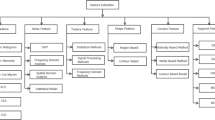Abstract
Generally, the blind peoples have several visual complications in doing their daily actions. So, the computer vision structure is used to developing the visually weakened life eminence. Unfortunately, the world is not contains any type of previous intermediate or interface. The proposed system is able to retrieve the text contents from the images and processes them with various edges. The anticipated system is used to engender the speech as several text documents. This document results with an effectual processing of text and segmenting of text from the images to support in actual text detection. The anticipated process is executed in the working platform of MATLAB and the consequences are examined by the obtainable processes.


Similar content being viewed by others
References
Santhana Kumar, D., Ashiq Irphan, K.: Speech Recognition Examination System for physically challenged people using android. J. Res. Comput. Sci. Technol. 2(4) (2016)
Cecilio, J., Duarte, K., Furtado, P.: BlindeDroid: an information tracking system for real-time guiding of blind people. J. Procedia Comput. Sci. 52, 113–120 (2015)
Anupriya, A., Vijayalakshmi, S.: An efficient examination system for blinds with real time voice interface. J. Comput. Sci. Mob. Comput. 4(3), 345–348 (2015)
Khan, S.: Voice based online examination for physically challenged. Int. J. Comput. Sci. Inf. Technol. 5(2), 58–61 (2015)
Fook, C.Y., Hariharan, M., Yaacob, S., Adom, A.H.: A review: Malay speech recognition and audio visual speech recognition. In: International Conference on Biomedical Engineering, pp. 479–484, 2012
Saini, P., Kaur, P.: Automatic speech recognition: a review. Int. J. Eng. Trends Technol. 4(2) (2013). http://www.internationaljournalssrg.org
Nereveettil, C.J., Kalamani, M., Valarmathy, S.: Feature selection algorithm for automatic speech recognition based on fuzzy logic. Int. J. Adv. Res. Electr. Electron. Instrum. Eng. 3(1) (2014). www.ijareeie.com
Ganesh, S., Kumar, S., Shankar, Raj, S.D., Kartik, R.: A novel voice recognition system for dumb people. J. Theor. Appl. Inf. Technol. 56(2), 296–304 (2013)
Shi, C., Wang, C., Xiao, B., Zhang, Y., Gao, S.: Scene text detection using graph model built upon maximally stable extremal region. Pattern Recognit. Lett. 34(2), 107–116 (2013)
Wang, K., Babenko, B., Belongie, S.: End-to-end scene text recognition. In: International Conference on Computer Vision ICCV 2011, vol. 10, pp. 1457–1464
Sumathi, C.P., Santhanam, T., Gayathri Devi, G.: A survey on various approaches of text extraction images. Int. J. Comput. Sci. Eng. Surv. 3, 27–42 (2012)
Yin, X.-C., Yin, X., Huang, K., Hao, H.W.: Robust text detection in natural scene images. IEEE Trans. Pattern Anal. Mach. Intell. 36, 970–983 (2013)
Zhang, H., Zhao, K., Song, Y.-Z., Guo, J.: Text extraction from natural scene image: a survey. J. Neurocomput. (2013). https://doi.org/10.1016/j.neucom.2013.05.037
Gopala Krishnan, K., Porkodi, C.M., Kanimozhi, K.: Image recognition for visually impaired people by sound. J. Commun. Signal Process. (2013). https://doi.org/10.1109/iccsp.2013.6577195
Naik, A., Patil, K., Patil, V.: E-Blind examination system. J. Innov. Res. Sci. Technol. 1(11), 238–242 (2015)
Ghosalkar, S., Pandey, S., Padhra, S., Apte, T.: Android application on examination using speech technology for blind people. J. Res. Comput. Commun. Technol. 3(3) (2011). www.ijrcct.org
Nandish, M.S., Balaji, C., Shantala, C.P.: An outdoor navigation with voice recognition security application for visually impaired people. J. Eng. Trends Technol. 10(10) (2014). http://www.ijettjournal.org
Harsur, A., Chitra, M.: Voice based navigation system for blind people using ultrasonic sensor. J. Recent Innov. Trends Comput. Commun. 3(6), 4117–4122 (2017)
Vats, A., et al.: Voice operated tool-examination portal for blind persons. J. Comput. Appl. (2016). https://doi.org/10.5120/ijca2016909989
Balakrishnan, N., Shantharajah, S.P.: An effective segmentation pattern using multi-class independent component analysis on high quality color texture images. Res. J. Appl. Sci. Eng. Technol. (2016). https://doi.org/10.19026/rjaset.12.2809
Author information
Authors and Affiliations
Corresponding author
Rights and permissions
About this article
Cite this article
Arunkumar, P., Shantharajah, S.P. & Geetha, M. Improved canny detection algorithm for processing and segmenting text from the images. Cluster Comput 22 (Suppl 3), 7015–7021 (2019). https://doi.org/10.1007/s10586-018-2056-8
Received:
Revised:
Accepted:
Published:
Issue Date:
DOI: https://doi.org/10.1007/s10586-018-2056-8




